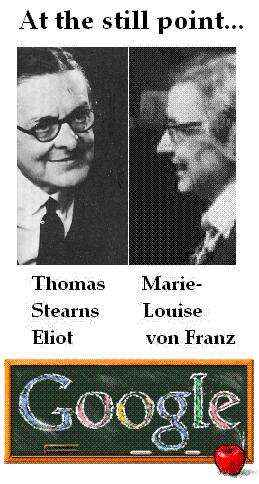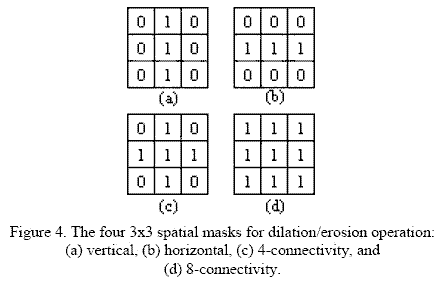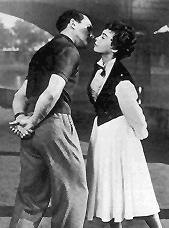|
The Crimson Passion:
A Drama at Mardi Gras continues. See Feb. 21 and 22 and the previous entry. In related news:
  |
Tuesday, February 28, 2006
Tuesday February 28, 2006
Monday, February 27, 2006
Monday February 27, 2006
Monday February 27, 2006
Point Counter Point
From the Encyclopaedia Britannica, 11th Edition, 1911:
COUNTERPOINT (Lat. contrapunctus, “point counter point,” “note against note”)
“In music, the art happily defined by Sir Frederick Gore Ouseley as that ‘of combining’ melodies….
Double Counterpoint is a combination of melodies so designed that either can be taken above or below the other. When this change of position is effected by merely altering the OCTAVE (from Lat. octavus, eighth, octo, eight) of either or both melodies (with or without transposition of the whole combination to another KEY), the artistic value of the device is simply that of the raising of the lower melody to the surface. The harmonic scheme remains the same, except in so far as some of the chords are not in their fundamental position, while others, not originally fundamental, have become so. But double counterpoint may be in other intervals than the octave; that is to say, while one of the parts remains stationary, the other may be transposed above or below it by some interval other than an octave, thus producing an entirely different set of harmonies.”
biography of Aldous Huxley
and the entry below.
Related material:
A Contrapuntal Theme.
Monday February 27, 2006
Sudden View
From John O'Hara's Birthday:
"We stopped at the Trocadero and there was hardly anyone there. We had Lanson 1926. 'Drink up, sweet. You gotta go some. How I love music. Frère Jacques, Cuernavaca, ach du lieber August. All languages. A walking Berlitz. Berlitz sounds like you with that champagne, my sweet, or how you're gonna sound.'"
— John O'Hara, Hope of Heaven, Chapter 11, 1938
"And they were all filled with the Holy Ghost, and began to speak with other tongues, as the Spirit gave them utterance."
"Lps. The keys to. Given! A way a lone a last a loved a long the
PARIS,
1922-1939."
— James Joyce, conclusion of Finnegans Wake
"Using illustrative material from religion, myth, and culture, he starts with the descent of the dove on Jesus and ends with the poetic ramblings of James Joyce."
— Review of a biography of the Holy Spirit
Monica Potts in today's New York Times on Sybille Bedford:
"Though her works were not always widely popular, they inspired a deeply fervent following of committed admirers, starting with her first published work, A Sudden View, in 1953. Later retitled A Visit to Don Otavio, it was an account of her journey through Mexico."
… "I addressed him. 'Is Cuernavaca not below Mexico City?'
'It is low.'
'Then what is this?' Another summit had sprung up above a curve.
'At your orders, the Three Marias.'
'What are the Three Marias?'
'These.'
Later, I learned from Terry that they were the three peaks by the La Cima Pass which is indeed one of the highest passes in the Republic; and still later from experience, that before running down to anywhere in this country one must first run up some six or seven thousand feet. The descents are more alarming than the climbs. We hurtled towards Cuernavaca down unparapeted slopes with the speed and angle, if not the precision, of a scenic railway– cacti flashed past like telegraph poles, the sun was brilliant, the air like laughing gas, below an enchanting valley, and the lack of brakes became part of a general allegro accelerando."
— Sybille Bedford, A Sudden View, Counterpoint Press, Counterpoint edition (April 2003), page 77
"How continually, how startlingly, the landscape changed! Now the fields were full of stones: there was a row of dead trees. An abandoned plough, silhouetted against the sky, raised its arms to heaven in mute supplication; another planet, he reflected again, a strange planet where, if you looked a little further, beyond the Tres Marias, you would find every sort of landscape at once, the Cotswolds, Windermere, New Hampshire, the meadows of the Eure-et-Loire, even the grey dunes of Cheshire, even the Sahara, a planet upon which, in the twinkling of an eye, you could change climates, and, if you cared to think so, in the crossing of a highway, three civilizations; but beautiful, there was no denying its beauty, fatal or cleansing as it happened to be, the beauty of the Earthly Paradise itself."
— Malcolm Lowry, Under the Volcano, Harper Perennial Modern Classics, 1st Perennial Classics edition (May 1, 2000), page 10
Friday, February 24, 2006
Friday February 24, 2006
Final Club
For the feast of St. Matthias
(traditional calendar)–
from Amazon.com, a quoted Library Journal review of Geoffrey Wolff‘s novel The Final Club:
“‘What other colleges call fraternities, Princeton calls Eating Clubs. The Final Club is a group of 12 Princeton seniors in 1958 who make their own, distinctive club….
Young adults may find this interesting, but older readers need not join The Final Club.’
— Previewed in Prepub Alert, Library Journal 5/1/90. Paul E. Hutchison, Fisherman’s Paradise, Bellefonte, Pa. Copyright 1990 Reed Business Information, Inc.”
From The Archivist, by Martha Cooley:
“Although I’ve always been called Matt, my first name isn’t Matthew but Matthias: after the disciple who replaced Judas Iscariot. By the time I was four, I knew a great deal about my namesake. More than once my mother read to me, from the New Testament, the story of how Matthias had been chosen by lot to take the place of dreadful Judas. Listening, I felt a large and frightened sympathy for my predecessor. No doubt a dark aura hung over Judas’s chair– something like the pervasive, bitter odor of Pall Malls in my father’s corner of the sofa.
As far as my mother was concerned, the lot of Matthias was the unquestionable outcome of an activity that seemed capricious to me: a stone-toss by the disciples. I tried with difficulty to picture a dozen men dressed in dust-colored robes and sandals, playing a child’s game. One of the Twelve had to carry on, my mother explained, after Judas had perpetrated his evil. The seat couldn’t be left empty. Hence Matthias: the Lord’s servants had pitched their stones, and his had traveled the farthest.”
Friday February 24, 2006
Thursday, February 23, 2006
Thursday February 23, 2006
Headline in today’s Harvard Crimson:
Crossroads

Instantia Crucis,
|
 Book cover, 1938 |
Thursday February 23, 2006
“In The Painted Word, a rumination on the state of American painting in the 1970s, Tom Wolfe described an epiphany….”
— Peter Berkowitz, “Literature in Theory”
“I had an epiphany.”
— Apostolos Doxiadis, organizer of last summer’s conference on mathematics and narrative. See the Log24 entry of 1:06 PM last August 23 and the four entries that preceded it.
“… das Durchleuchten des ewigen Glanzes des ‘Einen’ durch die materielle Erscheinung“
— A definition of beauty from Plotinus, via Werner Heisenberg
“By groping toward the light we are made to realize how deep the darkness is around us.”
— Arthur Koestler, The Call Girls: A Tragi-Comedy, Random House, 1973, page 118, quoted in The Shining of May 29
“Perhaps we are meant to see the story as a cubist retelling of the crucifixion….”
— Adam White Scoville, quoted in Cubist Crucifixion, on Iain Pears’s novel, An Instance of the Fingerpost
Wednesday, February 22, 2006
Wednesday February 22, 2006
The page below is from
The Regenerate Lyric:
Theology and Innovation
in American Poetry,
by Elisa New.

Related material:
Log24, Oct. 5, 2005–
New Page for Harvard’s President—
and the Harvard Crimson‘s
Wedding Bells Ring Anew for Summers.
Related only through metaphor:
The Crucifixion of John O’Hara,
Appointment in Samarra,
and Samarra Shrine.
Wednesday February 22, 2006
his boutonniere
on the left lapel,
nearest to his heart.
Buttonieres are generally
single blossoms
such as rosebuds.”

Rosebud

Crimson photo by Vilsa E. Curto
Tuesday, February 21, 2006
Tuesday February 21, 2006
"Contemporary literary theory did not emerge in an intellectual and cultural vacuum. The subordination of art to argument and ideas has been a long time in the works. In The Painted Word, a rumination on the state of American painting in the 1970s, Tom Wolfe described an epiphany he had one Sunday morning while reading an article in the New York Times on an exhibit at Yale University. To appreciate contemporary art– the paintings of Jackson Pollock and still more so his followers– which to the naked eye appeared indistinguishable from kindergarten splatterings and which provided little immediate pleasure or illumination, it was 'crucial,' Wolfe realized, to have a 'persuasive theory,' a prefabricated conceptual lens to make sense of the work and bring into focus the artist's point. From there it was just a short step to the belief that the critic who supplies the theories is the equal, if not the superior, of the artist who creates the painting."
— Peter Berkowitz, "Literature in Theory"

Cover art by Rea Irvin
On this date in 1925,
The New Yorker
first appeared.
Related material:
Aldous Huxley on
The Perennial Philosophy
(ART WARS, March 13, 2003)
and William James on religion:
For an experience that is
perhaps more effable,
see the oeuvre of
Jill St. John.

Related material:
A drama for Mardi Gras,
The Crimson Passion,
and (postscript of 2:56 PM)
today's Harvard Crimson
(pdf, 843k)
Tuesday February 21, 2006
Now Lens
| murphy plant, murphy grow, a maryamyria- | 10 | ||
| meliamurphies, in the lazily eye of his lapis, | 11 | ||
| 12 | |||

|
13 | ||
| 14 | |||
| Uteralterance or | Vieus Von DVbLIn, 'twas one of dozedeams | 15 | |
| the Interplay of | a darkies ding in dewood) the Turnpike under | 16 | |
| Bones in the | the Great Ulm (with Mearingstone in Fore | 17 | |
| Womb. | ground). 1 Given now ann linch you take enn | 18 | |
| all. Allow me! And, heaving alljawbreakical | 19 | ||
| expressions out of old Sare Isaac's 2 universal | 20 | ||
| The Vortex. | of specious aristmystic unsaid, A is for Anna | 21 | |
| Spring of Sprung | like L is for liv. Aha hahah, Ante Ann you're | 22 | |
| Verse. The Ver- | apt to ape aunty annalive! Dawn gives rise. | 23 | |
| tex. | Lo, lo, lives love! Eve takes fall. La, la, laugh | 24 | |
| leaves alass! Aiaiaiai, Antiann, we're last to | 25 | ||
| the lost, Loulou! Tis perfect. Now (lens | 26 |
— Finnegans Wake, Book II,
Episode 2, page 293Related material:
Fours and 1132
Monday, February 20, 2006
Monday February 20, 2006
New Site
(Site title and address were revised on May 21, 2006.)
The new site for my math files is
finitegeometry.org/sc/index.html:
 |
Finite Geometry |
|
This site is about the (the mathematical structure, |
|
As time goes on, I'll be changing links on the Web to my math pages, which are now scattered at various Web addresses, to refer to this new site.
Incidentally, this is the 20th anniversary of my note, "The relativity problem in finite geometry."
Monday February 20, 2006
The Past Revisited
From Log24 a year ago on this date, a quote from Many Dimensions (1931), by Charles Williams:
“Lord Arglay had a suspicion that the Stone would be purely logical. Yes, he thought, but what, in that sense, were the rules of its pure logic?”
For the rest of the story, see the downloadable version at Project Gutenberg of Australia.
Sunday, February 19, 2006
Sunday February 19, 2006
But seriously…
(continued)
The Matrix:
Click on pictures for details.
In memory of George T. Davis,
who died on February 4,
a Hollywood ending:
“Santa Claus rides alone.”
— Clint Eastwood
Sunday February 19, 2006
The Dirty Thirty
- Amy Tan, born Feb. 19, 1952, in Oakland, California, and
- the late Lee Marvin, born Feb. 19, 1924, in New York City.
For Amy Tan:
“Tan has a strong distaste for ‘hodge-podge collections’ that have no unifying theme. But as fate would have it, she had just recently recognized the common thread running through her own work.
‘It has to do with my upbringing with a father who very strongly believed in faith as a Baptist minister, and my mother, who very strongly believed in fate, and I’m trying to find things that work for me.’
She proposed a collection based upon her lifelong search for a philosophical middle ground between faith and fate, to be called The Opposite of Fate. When her puzzled editor asked her what the opposite of fate might be, Tan cryptically replied, ‘Exactly!'”
For Lee Marvin:
“On Feb. 19, 1945, during World War II, some thirty thousand U.S. Marines landed on Iwo Jima, where they began a monthlong battle to seize control of the island from Japanese forces.”
— Adapted from “Today’s Highlight in History,” by the Associated Press
Friday, February 17, 2006
Friday February 17, 2006
At the most vulnerable juncture of his half-decade at Harvard’s helm, Summers now faces a fuming Faculty with few vocal supporters by his side.
And many of his longtime allies are expressing disaffection with what they see as the president’s ineffective leadership.
“If he’s going to be like every other college president– just a caretaker, fundraiser, and a mouther of platitudes– then why do we need someone who’s also going to offend people?” said psychologist Steven Pinker, who was one of Summers’ most prominent supporters last year….
Pinker, while saying he wasn’t sure if the Corporation should take any public steps, said he hoped the board would, at least, intervene privately with the president.“I would like them to give some guidance to Summers and to say, ‘Things aren’t going well. You’ve got to either bring back some leadership and make sure that trains run on time and start new initiatives that you originally wanted to bring– or else get out of the way,'” Pinker said.
— Anton S. Troianovski

Who’ll be my role model
Now that my role model is
Gone, gone?
— Paul Simon
Thursday, February 16, 2006
Thursday February 16, 2006
Rabbi Yehuda Chitrik, storyteller
From James A. Michener‘s The Source:
“Trouble started in a quarter that neither Uriel nor Zadok could have foreseen. For many generations the wiser men of Zadok’s clan had worshipped El-Shaddai with the understanding that whereas Canaanites and Egyptians could see their gods directly, El-Shaddai was invisible and inhabited no specific place. Unequivocally the Hebrew patriarchs had preached this concept and the sager men of the clans accepted it, but to the average Hebrew who was not a philosopher the theory of a god who lived nowhere, who did not even exist in corporeal form, was not easy to comprehend. Such people were willing to agree with Zadok that their god did not live on this mountain– the one directly ahead– but they suspected that he did live on some mountain nearby, and when they said this they pictured an elderly man with a white beard who lived in a proper tent and whom they might one day see and touch. If questioned, they would have said that they expected El-Shaddai to look much like their father Zadok, but with a longer beard, a stronger voice, and more penetrating eyes.
Now, as these simpler-minded Hebrews settled down outside the walls of Makor, they began to see Canaanite processions leave the main gate and climb the mountain to the north, seeking the high place where Baal lived, and they witnessed the joy which men experienced when visiting their god, and the Hebrews began in subtle ways and easy steps to evolve the idea that Baal, who obviously lived in a mountain, and El-Shaddai, who was reported to do so, must have much in common. Furtively at first, and then openly, they began to climb the footpath to the place of Baal, where they found a monolith rising from the highest point of rock. Here was a tangible thing they could comprehend, and after much searching along the face of the mountain, a group of Hebrew men found a straight rock of size equal to the one accorded Baal, and with much effort they dragged it one starless night to the mountain top, where they installed it not far from the home of Baal….”
Valentine’s Day, 2006,
having had a heart attack
on Feb. 8, 2006–


The above monolith is perhaps more
closely related to El-Shaddai than to
Madonna, Grammy Night, and Baal.
It reflects my own interests
(Mathematics and Narrative)
and those of Martin Buber
(Jews on Fiction):

|
Wednesday, February 15, 2006
Wednesday February 15, 2006
Writes Screenplay
About God, Life & Death
These topics may be illuminated
by a study of the Chinese classics.

If we replace the Chinese word "I"
(change, transformation) with the
word "permutation," the relevance
of Western mathematics (which
some might call "the Logos") to
the I Ching ("Changes Classic")
beomes apparent.
Related material:
Hitler's Still Point,
Jung's Imago,
Solomon's Cube,
Geometry of the I Ching,
and Globe Award.
Yesterday's Valentine
may also have some relevance.
Tuesday, February 14, 2006
Tuesday February 14, 2006
— Charles Rosen, review of The Oxford History of Western Music in the Feb. 23, 2006, New York Review of Books
The first person that comes to mind as fitting both left and right descriptions is T. S. Eliot. Hence the following:

 A Jungian on this six-line figure: “They are the same six lines that exist in the I Ching…. Now observe the square more closely: four of the lines are of equal length, the other two are longer…. For this reason symmetry cannot be statically produced and a dance results.” |
Monday, February 13, 2006
Monday February 13, 2006
As yesterday’s Lincoln’s Birthday entry indicated, my own sympathies are not with the “created equal” crowd. Still, the Catholic Fascism of Franco admirer Andrew Cusack seems somewhat over-the-top. A more thoughtful approach to these matters may be found in a recommendation by Ross Douthat at The American Scene:
Read Eve Tushnet on the virtues of The Man in the High Castle.
Related material: Log24 on Nov. 14, Nov. 15, and Nov. 16, 2003.
Another item of interest from Eve:
“Transubstantiation [is equivalent but not equal to] art (deceptive accident hides truthful substance), as vs. Plato’s condemnation of the physical & the fictive? (Geo. Steiner)”
Related material:
(excerpt)
by Father Richard John Neuhaus,
First Things 115 (Aug.-Sept. 2001), 47-56:
“In Grammars of Creation, more than in his 1989 book Real Presences, Steiner acknowledges that his argument rests on inescapably Christian foundations. In fact, he has in the past sometimes written in a strongly anti–Christian vein, while the present book reflects the influence of, among others, Miri Rubin, whose Corpus Christi: The Eucharist in Late Medieval Culture is credited in a footnote. Steiner asserts that, after the Platonisms and Gnosticisms of late antiquity, it is the doctrines of incarnation and transubstantiation that mark ‘the disciplining of Western syntax and conceptualization’ in philosophy and art. ‘Every heading met with in a study of “creation,” every nuance of analytic and figural discourse,’ he says, derives from incarnation and transubstantiation, ‘concepts utterly alien to either Judaic or Hellenic perspectives– though they did, in a sense, arise from the collisions and commerce between both.’….
The incarnation of God in the Son, the transubstantiation of bread and wine into his body and blood, are ‘a mysterium, an articulated, subtly innervated attempt to reason the irrational at the very highest levels of intellectual pressure.’ ‘Uniquely, perhaps, the hammering out of the teaching of the eucharist compels Western thought to relate the depth of the unconscious and of pre-history with speculative abstractions at the boundaries of logic and of linguistic philosophy.’ Later, the ‘perhaps’ in that claim seems to have disappeared:
At every significant point, Western philosophies of art and Western poetics draw their secular idiom from the substratum of Christological debate. Like no other event in our mental history, the postulate of God’s kenosis through Jesus and of the never-ending availability of the Savior in the wafer and wine of the eucharist, conditions not only the development of Western art and rhetoric itself, but at a much deeper level, that of our understanding and reception of the truth of art– a truth antithetical to the condemnation of the fictive in Plato.
This truth reaches its unrepeated perfection in Dante, says Steiner. In Dante, ‘It rounds in glory the investigation of creativity and creation, of divine authorship and human poesis, of the concentric spheres of the aesthetic, the philosophical, and the theological. Now truth and fiction are made one, now imagination is prayer, and Plato’s exile of the poets refuted.’ In the fashionable critical theories of our day, we witness ‘endeavors of the aesthetic to flee from incarnation.’ ‘It is the old heresies which revive in the models of absence, of negation or erasure, of the deferral of meaning in late–twentieth–century deconstruction. The counter-semantics of the deconstructionist, his refusal to ascribe a stable significance to the sign, are moves familiar to [an earlier] negative theology.’ Heidegger’s poetics of ‘pure immanence’ are but one more attempt ‘to liberate our experience of sense and of form from the grip of the theophanic.’ But, Steiner suggests, attempted flights from the reality of Corpus Christi will not carry the day. ‘Two millennia are only a brief moment.’
Sunday, February 12, 2006
Sunday February 12, 2006
Proposition
“… a new nation, conceived in liberty and dedicated to the proposition that all men are created equal”
— Speech, A. Lincoln, Nov. 19, 1863
Some are less equal than others.
Proof:
Jacques Herbrand, born on this date in 1908.
“Herbrand… worked on field theory, considering abelian extensions of algebraic number fields. In the few months on which he worked on this topic, Herbrand published ten papers. These papers simplify proofs of results by Kronecker, Heinrich Weber, Hilbert, Takagi and Artin. Herbrand also generalised some of the results by these workers in class field theory as well as proving some important new theorems of his own.” –MacTutor
See
Saturday, February 11, 2006
Saturday February 11, 2006
a Dreamcatcher
For “the great Ojibwe tribe”
(A phrase from the lyrics to
“Broken Feather Blues,”
by Pat Donohue,
performed on tonight’s
Prairie Home Companion)

 |
 |
See also the recent entries
Zen Koan and Blue Dream,
as well as
Saturday February 11, 2006
Ignorance
Thought for Today:
“What we respect we always do,
but what we do not respect we ignore.’
— Associated Press, Feb. 11, 2006

Saturday February 11, 2006
From Dogma Part II: Amores Perros:
"Do Catholics believe that when you die your soul goes up in the sky? To heaven, if they go to heaven?"
— Hope of Heaven, by John O'Hara (1938), Carroll & Graf paperback, 1985, page 162
"My blue dream of being in a basket like a kite held by a rope against the wind…. It's fun to stretch and see the blue heavens spreading once more, spreading azure thighs for adventure."
— F. Scott Fitzgerald, The Last Tycoon (1941), Collier paperback, 1986, page 162
The following work of art
illustrates the above remarks.

Friday, February 10, 2006
Friday February 10, 2006
‘Tawdry Shleifer Affair’
Stokes Faculty Anger
Toward Summers
A case for Joseph Finder…
or for Steve Martin?

Friday February 10, 2006
In memory of Akira Ifukube (pdf), composer of music for “Godzilla,” who died on Wednesday, Feb. 8, 2006… birthday of John “Star Wars” Williams–
Thursday, February 9, 2006
Thursday February 9, 2006

Karen E. Fields, translator’s introduction to Elementary Forms of the Religious Life, by Emile Durkheim:
“Durkheim breathed the air of turn-of-the-century Paris, a place that fizzed with experiments in artistic representation, and a time when philosophy, science, and art existed in nothing like today’s isolation from one another.24
24 Judith Ryan provides an illuminating account of the links joining physics, psychology, philosophy, painting, and literature in The Vanishing Subject: Early Psychology and Literary Modernism, Chicago, University of Chicago Press, 1991.”
And today’s Crimson provides an illuminating account of Judith Ryan and (implicitly) forms of the religious life at Harvard.
Thursday February 9, 2006
Space, Time, and Scarlett
From last night’s Grammy awards, lyrics performed by Christina Aguilera and Herbie Hancock:
“a place where there’s no space or time”
— Leon Russell
Not bad, but as Kat358 noted on May 4, 2005,
“Scarlett Johansson does this ‘old Hollywood glam’ look much better.”
For a reference to the place described in Russell’s lyrics, see the riff on the number “265”
linked to in last night’s “Midnight in the Garden of the Soul.”
Related material– Jazz Improvisation:
“Once an appropriate group of people has been assembled, you must decide what to play.”
Thursday February 9, 2006
of the Soul
(continued)This time slot, reserved at midnight,
seems to belong to Frank Goodman,
who, according to this morning’s
(3 AM) New York Times, was
“one of the last of the old-time
Broadway press agents.”
Related material:
Yesterday afternoon’s entry
on a fictional “press agent
for ‘The Garden of the Soul,'”
and the entry on death
and gardens from Friday,
Feb. 3, 2006, the day
Frank Goodman died.
Wednesday, February 8, 2006
Wednesday February 8, 2006
From A Mass for Lucero:
“To the two gods of art, Apollo and Dionysus, we owe our recognition that… there is a tremendous opposition, as regards both origins and aims, between the Apolline art of the sculptor and the non-visual, Dionysiac art of music.”
— The Birth of Tragedy, by Friedrich Nietzsche, Penguin, 1993, page 14
“Melody, then, is both primary and universal.” (Author’s italics)
— Nietzsche, op. cit., page 33
“…in so far as he interprets music in images, he himself lies amidst the peaceful waves of Apolline contemplation….”
— Nietzsche, op. cit., page 35
From The Miracle of the Bells, by Russell Janney, Prentice-Hall, 1946, page 333–
“He was singing softly:
‘A pretty girl–
is like a melody—- !‘
But that was always
Bill Dunnigan’s
Song of Victory….
Thus thought the…
press agent for
‘The Garden of the Soul.'”
Wednesday February 8, 2006
(continued)
“… iconography,
the concept and image
of the bride of Christ–
the sponsa Christi—
assumed particular relevance in
the definition of women’s identity.”
— Silvia Evangelisti in
Historiographical Reviews

Related material:
|
Arts & Letters Daily
(Feb. 8, 2006) annotated: Dan Brown is not the first to have suggested that Jesus had a sex life– even Martin Luther said it. So what about the lady, Mary Magdalene?… more
For literature profs of today, Theory is what the Dialectic was to Marxist intellectuals of the past: the key to almost everything… more
The idea that anyone, regardless of learning or class, could “come to Christ” went along with the idea of equal rights in America. William Jennings Bryan… more
|
And from non-Protestantism, for the birthday of
Sanctus from Missa “Veni Sponsa Christi” (pdf), by Manuel Cardoso (1566-1650).
Related material: Catholic Tastes and
A Mass for Lucero.
Tuesday, February 7, 2006
Tuesday February 7, 2006
Today’s birthdays:
E. T. Bell and G. H. Hardy.
I added a paragraph today to the diamond theorem page:
“Some of the patterns resulting from the action of G on D have been known for thousands of years. (See Jablan, Symmetry and Ornament, Ch. 2.6.) It is perhaps surprising that the patterns’ interrelationships and symmetries can be explained fully only by using mathematics discovered just recently (relative to the patterns’ age)– in particular, the theory of automorphism groups of finite geometries.”
This blend of mathematical history and mathematics proper seems not inappropriate for a birth date shared by a mathematical historian (Bell) and a pure mathematician (Hardy).
Monday, February 6, 2006
Monday February 6, 2006
are brought together the diamonds
inside of them will glow.”
— Harrison Ford in
“Indiana Jones and the
Temple of Doom”
In today’s online New York Times:
(1) A review of pop-archaeology TV,
“Digging for the Truth,”
(2) a Sunday news story,
“Looking for the Lie,”
(3) and a profile,
“Storyteller in the Family.”
From (1):
“The season premiere ‘Digging for the Truth: The Real Temple of Doom,’ showed Mr. Bernstein in South America, exploring tunnels….”
From (2):
“… scientists are building a cognitive theory of deception to show what lying looks like….”
From (3):
“I did feel one had to get not just the facts, but the emotional underpinnings.”
Log24 on
Harrison Ford’s birthday
last July–

— and Mathematics and Narrative.
See also Saturday’s entry,
Raiders of the Lost Matrix,
for logic as an aid in
detecting lies.
Sunday, February 5, 2006
Sunday February 5, 2006
“The icon that I use… is the nine-fold square…. This is the garden of Apollo, the field of Reason….”
— Architect’s notes on the design of a college campus
“Binary image morphological operations are well suited to a large class of basic image processing applications. These operations include image analysis tasks such as shape recognition, image segmentation, noise reduction, and feature extraction.”

— A Programmable Logic-based Implementation of Ultra-fast Parallel Binary Image Morphological Operations (pdf), by Kenneth G. Ricks et al., ISCA 18th International Conference on Computers and Their Applications (March 2003)
Sunday February 5, 2006
Catholic Schools Sermon
For those who might be tempted today, following yesterday’s conclusion of Catholic Schools Week, to sing (for whatever reason) “Ding Dong, the Witch is Dead”–
Here, from his classic Witchcraft (first published by Faber and Faber, London, 1941, reprinted by Apocryphile Press, Berkeley, CA, Oct. 1, 2005) is Charles Williams on the strong resemblance between witchcraft and the rituals of the Church:
Witchcraft and the Church
From Witchcraft, 2005 Apocryphile edition, pages 77-80–
[77] … The predisposition towards the idea of magic might be said to begin with a moment which seems to be of fairly common experience– the moment when it seems that anything might turn into anything else. We have grown used– and properly used– to regarding this sensation invalid because, on the whole, things do not turn into other things except by processes which we realize, or else at least so frequently that we appreciate the probability. But the occasional sensation remains. A room, a street, a field becomes unsure. The edge of a possibility of utter alteration intrudes. A door, untouched, might close; a picture might walk; a tree might speak; an animal might not be an animal; a man might not be a man. One may be with a friend, and a terror will take one even while his admirable voice is speaking; one will be with a lover and the hand will become a different and terrifying thing, moving in one’s own like a malicious intruder, too real for anything but fear. All this may be due to racial memories or to any other cause; the point is that it exists. It exists and can be communicated; it can even be shared. There is, in our human centre, a heart-gripping fear of irrational change, of perilous and malevolent change.
Secondly, there is the human body, and the movements of the human body. Even now, when, as a general rule, the human body is not supposed to mean [78] anything, there are moments when it seems, in spite of ourselves, packed with significance. This sensation is almost exactly the opposite of the last. There, one was aware that any phenomenon might alter into another and truer self. Here, one is aware that a phenomenon, being wholly itself, is laden with universal meaning. A hand lighting a cigarette is the explanation of everything; a foot stepping from a train is the rock of all existence. If the first group of sensations are due to racial fear, I do not know to what the second group are due– unless indeed to the Mercy of God, who has not left us without a cloud of witnesses. But intellectually they are both as valid or invalid as each other; any distinction must be a matter of choice. And they justify each other, at least to this extent, that (although the first suggests irrationality and the second rationality) they both at first overthrow a simple trust that phenomena are what phenomena seem.
But if the human body is capable of seeming so, so are the controlled movements of the human body– ritual movements, or rather movements that seem like ritual. A finger pointing is quite capable of seeming not only a significant finger, but a ritual finger; an evocative finger; not only a finger of meaning, but a finger of magic. Two light dancing steps by a girl may (if one is in that state) appear to be what all the Schoolmen were trying to express; they are (only one cannot quite catch it) an intellectual statement of beatitude. But two quiet steps by an old man may seem like the very speech of hell. Or the other way round. Youth and age have nothing to do with it, nor did the ages that defined and [79] denounced witchcraft think so. The youngest witch, it is said, that was ever burned was a girl of eleven years old.
Ordered movement, ritual, is natural to men. But some ages are better at it, are more used to it, and more sensitive to it, than others. The Middle Ages liked great spectacle, and therefore (if for no other reasons– but there were many) they liked ritual. They were nourished by ritual– the Eucharist exhibited it. They made love by ritual– the convention of courtly love preserved it. Certainly also they did all these things without ritual– but ritual (outside the inner experience) was the norm. And ritual maintains and increases that natural sense of the significance of movement. And, of course, of formulae, of words.
The value of formulae was asserted to be very high. The whole religious life ‘as generally necessary to salvation’ depended on formulae. The High God had submitted himself to formulae. He sent his graces. He came Himself, according to ritual movements and ritual formulae. Words controlled the God. All generations who have believed in God have believed that He will come on interior prayer; not all that He will come, if not visibly yet in visible sacraments, on exterior incantation. But so it was. Water and a Triune formula concentrated grace; so did oil and other formulae; so– supremely– did bread and wine and yet other formulae. Invocations of saints were assumed, if less explicitly guaranteed, to be effective. The corollaries of the Incarnation had spread, in word and gesture, very far.
The sense of alteration, the sense of meaning, the [80] evocation of power, the expectation of the God, lay all about the world. The whole movement of the Church had, in its rituals, a remarkable similarity to the other rites it denounced. But the other rites had been there first, both in the Empire and outside the Empire. In many cases the Church turned them to its own purposes. But also in many cases it entirely failed to turn them to its own purposes. In many cases it adopted statues and shrines. But in others it was adopted by, at least, the less serious spells and incantations. Wells and trees were dedicated to saints. But the offerings at many wells and trees were to something other than the saint; had it not been so they would not have been, as we find they often were, forbidden. Within this double and intertwined life existed those other capacities, of which we know more now, but of which we still know little– clairvoyance, clairaudience, foresight, telepathy.
Sunday February 5, 2006
Saturday, February 4, 2006
Saturday February 4, 2006
the Lost Matrix
(continued)
|
The Archaeologist
with a Thousand Faces "From often humble beginnings, and often with a childhood fascination for antiquity, the archaeologist leaves familiar surroundings to undergo exacting professional training under a series of mentors and when armed, at last, with the intellectual weapons of the profession, sets off for unfamiliar or exotic realms, braving opposition and danger to solve an ancient mystery. The lives of… real-life archaeologists… have lent themselves to this style of retelling… as have such fictional heroes as John Cullinane (Michener 1965) and Indiana Jones." — From "Promised Lands and Chosen Peoples: The Politics and Poetics of Archaeological Narrative," by Neil Asher Silberman, pp. 249-262 in Nationalism, Politics, and the Practice of Archaeology, edited by Philip L. Kohl and Clare Fawcett, Cambridge University Press, paperback, published Feb. 8, 1996. |
From Today in History,
by the Associated Press:
Thought for Today:
"Character consists of what you do
on the third and fourth tries."
— James Michener,
American author (1907-1997),
attributed by
Simpson's Contemporary Quotations
to Chesapeake, Random House, 78.
The Matrix:

First try:
On Linguistic Creation
June 25, 1999
Second try:
Art Wars: Picasso's Birthday,
Oct. 25, 2002
Third try:
Matrix of the Death God,
May 25, 2003
Fourth try:
Happy Birthday,
July 26, 2004
Friday, February 3, 2006
Friday February 3, 2006

Related material:
Log 24, Sunday, January 29, 2006,
and links in the previous entry–
A Contrapuntal Theme and
Good Will Writing.
|
Beauty is momentary in the mind– The body dies; the body’s beauty lives. — Wallace Stevens, |
Thursday, February 2, 2006
Thursday February 2, 2006
In memory of
Christopher James Makins,
2nd Baron Sherfield,
Fellow of All Souls:
Related material:
Good Will Writing,
A Contrapuntal Theme,
Ideas, Stories, Values,
as well as
Toot! Toot! Off we go!
Thursday February 2, 2006
continued

The Gospel According to
Father Hardon:
TELEPATHY. The direct communication of ideas from one mind to another without words, signs, gestures, or any other ordinary means of communicating thought. Extensive data and years of psychical research indicate that such manner of communicating knowledge does occur in exceptional cases or with exceptional people. When verified, the phenomenon is purely natural and the use of telepathic powers by one who possesses them cannot be called divination, nor does their use pose any special moral problems. It should be judged by the general principles applicable to any other human being’s behavior.
It is altogether another question whether in a given case of reputed telepathy any preternatural agency has been active. Instances of supposed communication of thought without verbal or other sensory means are reported in the lives of the saints. But the Church does not hold that such phenomena are positive signs of a person’s sanctity. (Etym. Greek tēle, at a distance + pathein, to experience.)
Related material:
 |
 |
Thursday February 2, 2006
From today’s New York Times,
“Frey Says Falsehoods Improved His Tale“–
“Overall, his portrayal in A Million Little Pieces is of a person who ‘I created in my mind to help me cope’ with drug addiction and recovery. He said most of the invented material ‘portrayed me in ways that made me tougher and more daring and more aggressive than in reality I was, or I am.'”
A not uncommon strategy.
Humpty Dumpty.
Wednesday, February 1, 2006
Wednesday February 1, 2006

See also
Russell Crowe as Santa’s helper,
Communion, and the subsequent
Playing God: The Color of Collateral.
From “Collateral“–
FELIX: Do you believe
in Humpty Dumpty?
MAX: No.
FELIX: Do you believe
in Santa Claus?
MAX: No.
FELIX: Neither do I.
But my children do.
They are still small.
But do you know who they like
even better than Santa Claus?
His helper, Pedro Negro. Black Peter.
There’s an old Mexican tale that tells
of how Santa Claus got so very busy
looking out for the good children
that he had to hire some help
to look out for the bad children.
So he hired Pedro.
And Santa Claus gave him a list….

Wednesday February 1, 2006
“Good Night and Good Luck”
— Morgan Freeman, closing remarks
at the Screen Actors Guild Awards
on January 29, 2006
 A History of Death |
 |
Review by Stephen Hunter
of “Good Night and Good Luck”–
“The film, therefore, is like
a child’s view of these events,
untroubled by complexity,
hungry for myth and simplicity.”
“A larger poem for a larger audience….
A mythological form, a festival sphere,
A great bosom, beard and being,
alive with age.”
— Wallace Stevens, quoted in
Log24, January 29, 2006

Stephen Hunter on Senator McCarthy:
He “forever tarnished
by association the reputations
of the security services
charged with keeping us safe
from the actual–
yes, Virginia, there was
such a thing– Red menace.”













